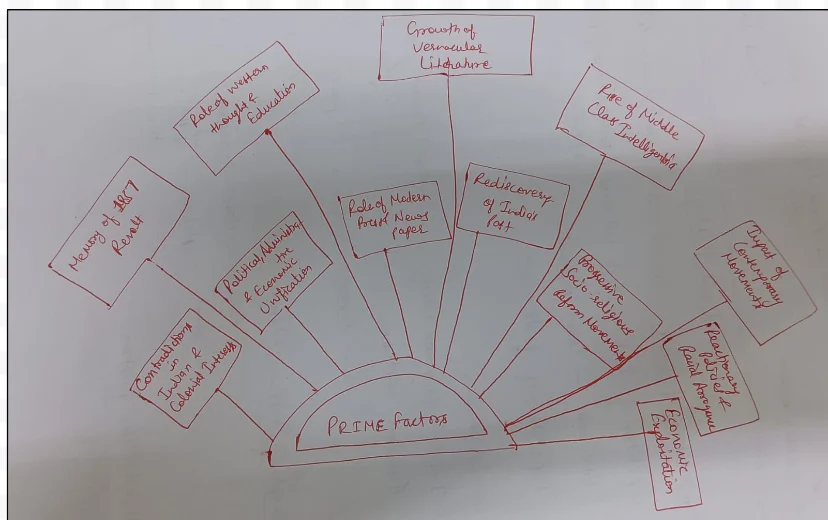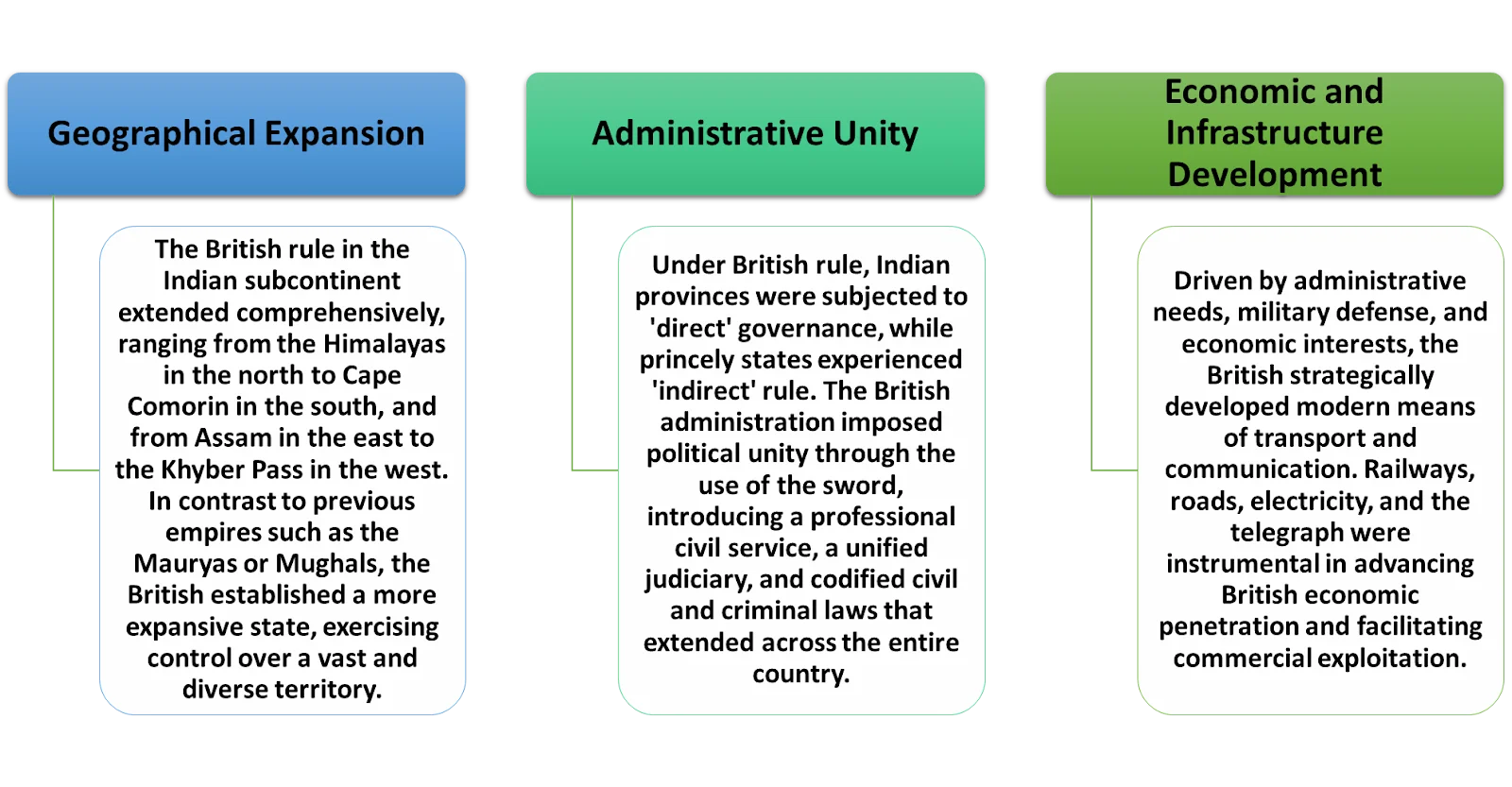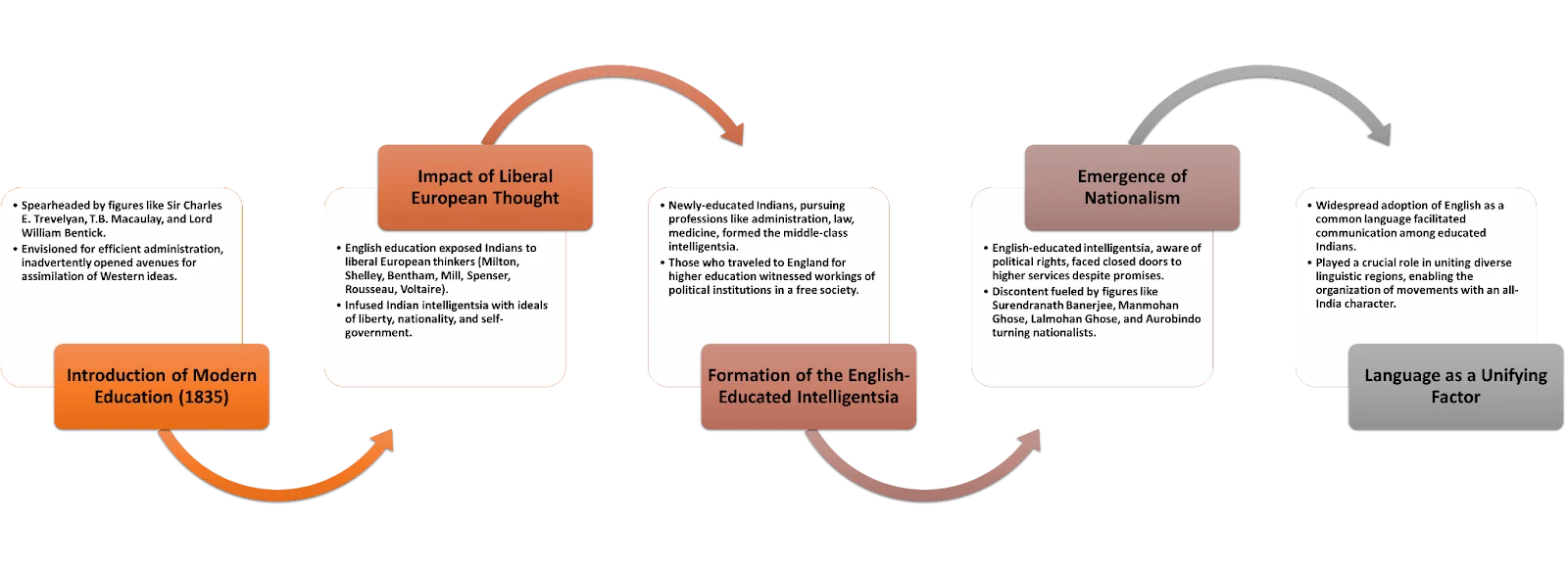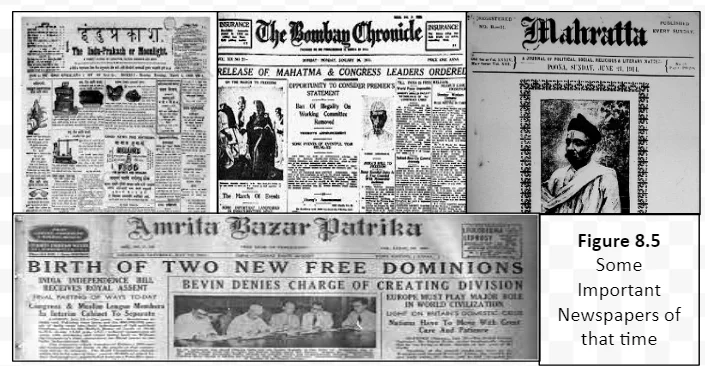Nationalism is a complex notion, which represents undoubting loyalty to one’s country and is commonly linked with culture, language, and history. It coincided with the anti-colonial movement in India and united many people against colonial oppression. This desire for independence takes different shapes and forms – from cultural preservation to political autonomy. It may endanger unity on shared ideals or disunity as factions clamor for different interests. The core element of nationalism stems from the feeling of identity and belongingness that greatly influences the way people perceive their politics and history at the regional and global levels.
Phases of Growth of National Movement
In 1885, a significant turning point unfolded in Indian history with the establishment of the Indian National Congress, marking the onset of a new era. Looking back at the National Movement, we can discern three overarching stages in its evolution.
- The early phase (1885-1905): The early phase (1885-1905) of the Congress was characterized by a somewhat nebulous vision, confined to a small segment of the educated middle-class intelligentsia, drawing inspiration from Western Liberal and Radical Thought.
- The second phase (1905-1918): As the movement progressed into its second stage (1905-1918), the Congress matured, broadening its objectives to encompass a comprehensive upliftment—social, cultural, economic, and political—while aspiring for self-government (Swaraj).
- Progressive factions within the Congress embraced Western revolutionary methods to counter Western Imperialism.
- The final phase (1919-47): The final stage (1919-47) was dominated by the pursuit of Purna Swaraj, or complete independence, led by Mahatma Gandhi through the uniquely Indian approach of non-violent non-cooperation.
Factors in the Growth of Indian Nationalism

Genesis of Indian Nationalism: The emergence and development of Indian nationalism are conventionally attributed to the response to stimulus generated by the British Raj. This response encompasses the introduction of new institutions, opportunities, and resources. Essentially, Indian nationalism evolved as a dual outcome—partly shaped by colonial policies and partly as a reaction to them.
Challenging the Colonial Narrative: This oversimplifies the rise of Indian nationalism, portraying a positive role for colonial rule. In truth, British colonial rulers opposed the growing Indian national consciousness in the late nineteenth century. British scholars dismissed India as a mere ‘geographical expression,’ with some doubting its ability to unify as a nation.
During the 19th century, with the evident growth and strengthening of nationalism, certain British scholars adopted a new stance, started giving credit to the British Raj for the growth of Indian nationalism. Contrary to this narrative, the truth was that Indian nationalism emerged as an unwelcome offspring of the Raj, an entity it initially neglected and later sought to suppress.
Thus, a more accurate perspective recognizes Indian nationalism as a product of a blend of diverse following factors:
1. Understanding of Contradictions in Indian and Colonial Interests
British colonial rulers employed modern approaches—politically, militarily, economically, and intellectually—to establish and perpetuate their dominance over India, aiming for the comprehensive exploitation of India’s resources.
- Impact of Colonial Modernization: The colonial scheme of administration also demanded a dose of modernisation, which despite being distortive brought upon certain developments, one of which was Indian nationalism.
- Common Cause: Gradually, people began to see that it was the colonial rule that retarded India and that the interests of the Indians were one and the same as those of all sections – peasants, artisans, handicraftsman, workers, intellectuals, the educated and the capitalists.
Thus, nationalism arose as an attempt to answer those contradictions which were inherent in its character and policies of colonialism.
2. The Memory of the Revolt of 1857
When nationalism was flaring up in the minds of Indian people, the memory of the Great Revolt
of 1857 flashed back before them. The heroic actions of Nana Sahib, Tatya Tope, Rani Laxmi Bai and other leaders of the Revolt became fresh in their minds.
- It inspired the people to cherish their memory and to give a toe fight to the British.
3. Unification of the Country: Political, Administrative and Economic

Lord Dalhousie left behind a legacy for Indians by introducing railways, telegraphs, and a new mode of postal system. From one side of India to the other, roads were linked to India. However, these all were meant for the imperialist interests, but the people of India capitalized it.
- A unity of country was manifested in the railway compartment. Railway compartments had been inhabited by all people, from North to South and to East and West and rich as well as poor people, masters and servants within it.
- It narrowed the gap among them and made them feel that they were part of this huge India under the British raj.
The British colonial strategy thus played a pivotal role in shaping the interconnected landscape of Indian nationalism.
- For example, on the occasion of the Delhi Durbar in 1877, the Indian journalists who were invited to this extravaganza took the opportunity to form a Native Press Association.
- They elected S.N. Banerjea, the leader of the Indian Association and the editor of Bengalee, as its first secretary and resolved to meet once or twice every year to discuss issues related to press and the country
This Political, Administrative and Economic unification process had a two-fold effect on Indian nationalism.
- Firstly, economic interdependence emerged, as the failure of crops in one region affected prices and supply in another.
- Secondly, the development of modern transport and communication brought leaders from diverse regions together, fostering the exchange of political ideas and facilitating the mobilization of public opinion on political and economic issues.
4. Role of Western Thought and Education
The inception of the modern education system in India, spearheaded by figures like Sir Charles E. Trevelyan, T.B. Macaulay, and Lord William Bentick in 1835, marked a pivotal moment. English education, envisioned for efficient administration, inadvertently opened avenues for the assimilation of Western ideas.
- Paradox of English Education: Trevelyan foresaw that English-educated Indians would play a role in the eventual demise of British rule, either through indigenous or Western-influenced political models.
- If this education was designed to colonise the mind of the Indian intelligentsia and breed in them a sense of loyalty, the Indian intelligentsia also selectively appropriated and manipulated that knowledge of domination to craft their own critique of colonialism.
- Expansion of Higher Education: Higher education began to grow rapidly in India after universities were established in the three presidencies in 1857 and education became a free enterprise in 1882.
| “The British raj in India could not last for ever. It was bound to die one day, either at the hands of those Indians who subscribed to the indigenous model of political change or at the hands of those who had been educated in English and subscribed to the new British model of political change. If it was to die at the hands of the latter, it would take a long time and the severance of the British connection with India would be neither violent nor harmful to Britain, for cultural and commercial bonds would continue”.
– Trevelyan argued before the Indian Committee of the House of Lords in 1835 |
- Liberal European Thought: English education exposed Indians to liberal European thinkers such as Milton, Shelley, Bentham, Mill, Spencer, Rousseau, and Voltaire.
- This exposure infused the Indian intelligentsia with ideals of liberty, nationality, and self-government, challenging the anachronism of British rule.
| “It may be that the public mind of India may expand under our system until it has outgrown that system, that by good government we may educate our subjects into a capacity for better government; that having become instructed in European language, they may, in some future age demand European institutions”.
– Lord Macaulay in a speech before the House of Commons in 1833 |
- Role of English Education in Shaping Nationalist Sentiments: The English language played a pivotal role, enabling nationalist leaders from diverse linguistic backgrounds to communicate effectively.
- Educated individuals, particularly those in liberal professions like law and medicine, often pursued higher education in England.
- On returning to India, they encountered a stifling political atmosphere, leading to discontent and frustration.
- From Education to Nationalism: This realisation fueled discontent, with figures like Surendranath Banerjee, Manmohan Ghose, Lalmohan Ghose, and Aurobindo turning nationalists. They became the leaders of a burgeoning political unrest, forming the core of early Indian political associations.
- English as a Unifying Force: The widespread adoption of English as a common language facilitated communication and collaboration among educated Indians across diverse regions.
- This linguistic common ground played a crucial role in uniting Bengalis, Panjabis, Tamilians, Maharastrians, and others, enabling the organization of movements with an all-India character.

5. Role of Modern Press and Newspaper
The rise of the modern press in the second half of the nineteenth century, both in English and Vernacular languages, was a consequence of British rule in India. Europeans introduced printing presses, publishing newspapers, and affordable literature. Despite periodic restrictions imposed by colonial rulers, Indian journalism progressed significantly during the time. Around 1877, there were approximately 169 vernacular newspapers, with a circulation nearing 100,000.

- Press as a Catalyst for Political Awakening and Unity: While the press critiqued official policies, it simultaneously urged people to unite. It played a pivotal role in disseminating modern concepts of self-government, democracy, civil rights, and industrialization.
- Role of Print Media in Fostering Inter-Regional Solidarity: Newspapers, journals, pamphlets, and nationalist literature facilitated the exchange of political ideas among leaders from diverse regions. These newspapers, as S.R. Mehrotra(Historian) writes, “broke down internal barriers and encouraged inter-regional solidarity”.
- Voices of Resistance: Newspapers like the Indian Mirror, the Bengalee, the Amrita Bazar Patrika, Bombay Chronicle, the Hindu Patriot, the Mahratta, Kesari, Andra Prakasika, The Hindu, Indu Prakash, Kohinur, among others in English and various Indian languages, exposed British Indian administration’s excesses and propagated ideas of representative government, liberty, democratic institutions, home rule, and independence.
It can be asserted that the press became the reflection of Indian nationalism and the primary vehicle for popular public education.
| Must Read | |
| Current Affairs | Editorial Analysis |
| Upsc Notes | Upsc Blogs |
| NCERT Notes | Free Main Answer Writing |
Conclusion
Indian nationalism emerged as a multifaceted force driven by colonial antagonism, socio-political awakening, and unification under British rule. From the early, fragmented efforts of the Indian National Congress to the cohesive, non-violent resistance led by Gandhi, the movement evolved through various stages. The rise of nationalism was significantly influenced by the British Raj’s modernization efforts, Western education, and the modern press, which together fostered a unified Indian identity and a powerful drive towards independence.
Sign up for the PWOnlyIAS Online Course by Physics Wallah and start your journey to IAS success today!
| Related Articles | |
| Three Different Stages of Colonialism | Mahatma Gandhi: The Nonviolent Force of Change |
| Indian National Movement | The Rise of Nationalism in India: Key Events and Movements |

 GS Foundation
GS Foundation Optional Course
Optional Course Combo Courses
Combo Courses Degree Program
Degree Program









